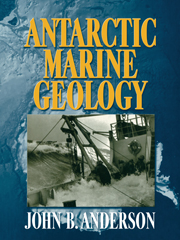Book contents
CHAPTER 6 - Antarctica's Glacial History
Published online by Cambridge University Press: 06 December 2010
Summary
To many geologists, the term “Ice Ages” conjures up information learned in undergraduate classes about Northern Hemisphere glaciation during the Pleistocene. Yet, the Antarctic Ice Sheet appears to have been in existence at least an order of magnitude longer than the Northern Hemisphere ice sheets, as far back as the Mid-Late Eocene. Throughout most of the late Cenozoic, the Antarctic Ice Sheet has driven global eustasy and deep ocean circulation. It has played a crucial role in regulating global climate, particularly in the Southern Hemisphere (Barrett, 1991; Denton, Prentice, and Burckle, 1991; Flower and Kennett, 1994). Only in more recent geologic time has the Antarctic Ice Sheet passed into a secondary role in the global cryosphere. Equilibrated with the polar climate, it responds to the fall and rise of sea level resulting from waxing and waning Northern Hemisphere ice sheets. Still, if there is to be any significant increase in global sea level over the next several centuries, it will likely come from Antarctica.
The first explorers to Antarctica recorded signs that the ice sheet has a history of expansion and contraction. The Polish explorer Arctowski (1901) was struck by the spectacular glacial landforms as he sailed along the inland passage of the Antarctic Peninsula. He stated, “We must not imagine that the Antarctic lands are at the present day as heavily loaded with glaciers as they might be, for traces of a wider extension, dating doubtless from the glacial epoch, are still preserved” (Arctowski, 1901; p. 372). Later, Scott (1905) suggested that Ross Ice Shelf had once stood at the edge of the continental shelf.
- Type
- Chapter
- Information
- Antarctic Marine Geology , pp. 207 - 248Publisher: Cambridge University PressPrint publication year: 1999



